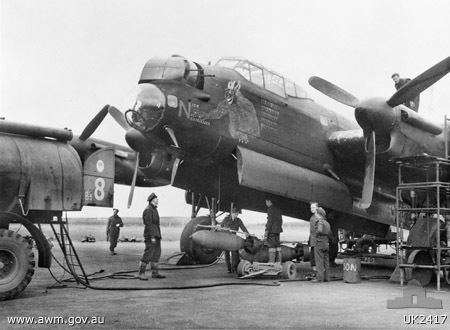Active 1943–45 Allegiance United Kingdom | Country Australia Role Bomber Squadron | |
 | ||
Part of | ||
No. 463 Squadron RAAF was a Royal Australian Air Force heavy bomber squadron during World War II. The squadron was formed in the United Kingdom in late 1943 from personnel and aircraft allocated from No. 467 Squadron RAAF. The squadron was equipped with Avro Lancaster bombers and flew its first raids on Germany immediately after being formed. Operating as part of RAF Bomber Command No. 463 Squadron conducted raids against cities, industrial facilities and military targets in Germany, France and Norway throughout 1944 and until the end of the war in May 1945. Following the war, the squadron evacuated Allied prisoners of war from Europe until it was disbanded in late 1945.
History
No. 463 Squadron was raised as an Article XV squadron under the terms of the Empire Air Training Scheme in the United Kingdom, and allocated to the Royal Australian Air Force. It came into being on 25 November 1943 when a flight of Avro Lancaster heavy bombers and supporting personnel were transferred from another Australian squadron, No. 467 Squadron RAAF. Upon formation, the squadron was established at RAF Waddington, in Lincolnshire, and its first commanding officer was Wing Commander Rollo Kingsford-Smith. It was assigned to No. 5 Group RAF.
The squadron commenced operations within a day of its formation, with its first mission being a night bombing mission over Berlin. This attack resulted in the loss of one Lancaster, but also saw the squadron shoot down its first German aircraft, a Junkers Ju 88 night fighter. Following its first operation, the squadron received more aircraft and although it was eventually expanded to two flights, it never achieved full strength of three flights.
For the first part of the squadron's existence, its operations were mainly focused on night bombing raids over Germany, attacking mainly the industrial areas of Berlin and the Ruhr. Later, as the squadron's focus shifted to targets in France during the lead up to the Normandy invasion. In early May, the squadron attacked German armoured formations in France and targeted German airfields; losses were heavy during these operations with four aircraft being lost in a single raid on 10/11 May. On the eve of D-Day, they attacked German coastal positions overlooking Omaha Beach in support of the Allied landings. Following the successful lodgement, the squadron continued to undertake ground support operations, and began daylight missions. Other operations were undertaken in the aerial photography role in support of the RAF Film Unit. In this capacity, one of the squadron's Lancasters set an endurance record flying a 14.5-hour mission to photograph the final attack on the German pocket battleship Tirpitz in Tromso Fjord, in Norway, in November 1944.
During 1945, the squadron's aircraft continued to fly operations against targets in Germany, and also in support of ground troops as the Allies advanced towards Germany. Daylight raids were also undertaken, and during one such raid on Hamburg in early April 1945, the squadron's aircraft came up against German Me 262 jet fighters for the first time. The squadron's final offensive operation of the war came on Anzac Day 1945, when 14 Lancasters from No. 463 Squadron bombed the Tonsberg oil refinery; one aircraft was lost during this raid, with the crew being interned in Sweden for the remainder of the war. Shortly afterwards, the squadron began transport duties, ferrying liberated Allied prisoners of war back to the United Kingdom.
In July, the squadron relocated to RAF Skellingthorpe, remaining there until it was disbanded in September or October 1945. Prior to its disbandment, it had been intended that No. 463 Squadron would form part of "Tiger Force", the British and Commonwealth contribution to the air forces allocated to attack Japan as part of Operation Downfall; however, the war in the Pacific ended before they could be deployed.
Throughout the course of the war, No. 463 Squadron undertook 2,525 sorties, and expended over 11,000 tons of bombs. The squadron was credited with shooting down six German aircraft, including one Bf-110 night fighter that was shot down by the crew of one Lancaster as it stalked another. Casualties amongst the squadron's aircrew were heavy, and No. 463 had the highest casualty rate of any Australian bomber squadron deployed to Europe during the war, with 78 aircraft being lost and 546 personnel being killed; of these 225 were Australian.
